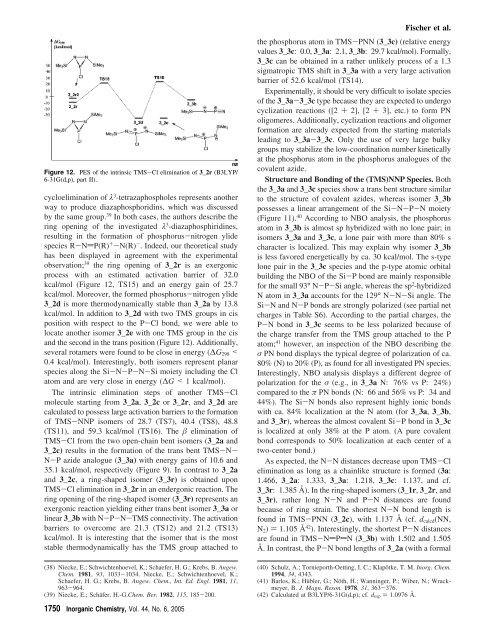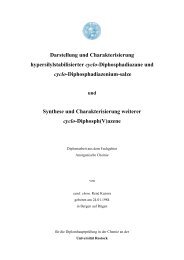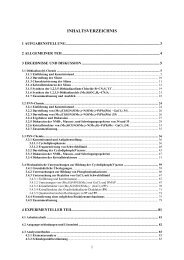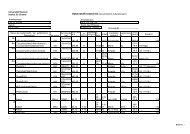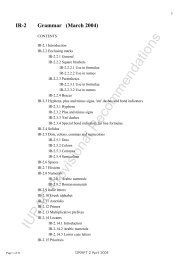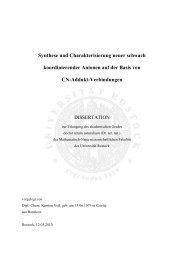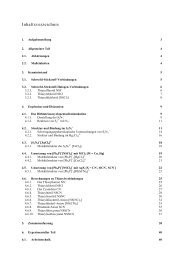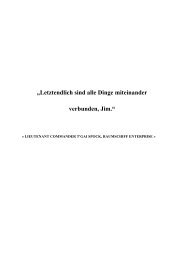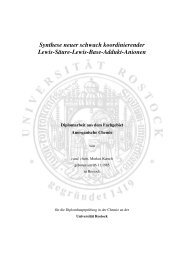Darstellung und Charakterisierung neuer niedrigkoordinierter ...
Darstellung und Charakterisierung neuer niedrigkoordinierter ...
Darstellung und Charakterisierung neuer niedrigkoordinierter ...
Create successful ePaper yourself
Turn your PDF publications into a flip-book with our unique Google optimized e-Paper software.
Figure 12. PES of the intrinsic TMS-Cl elimination of 3_2r (B3LYP/<br />
6-31G(d,p), part II).<br />
cycloelimination of λ 3 -tetrazaphospholes represents another<br />
way to produce diazaphosphoridins, which was discussed<br />
by the same group. 39 In both cases, the authors describe the<br />
ring opening of the investigated λ 3 -diazaphosphiridines,<br />
resulting in the formation of phosphorus-nitrogen ylide<br />
species R-NdP(R) + -N(R) - . Indeed, our theoretical study<br />
has been displayed in agreement with the experimental<br />
observation; 39 the ring opening of 3_2r is an exergonic<br />
process with an estimated activation barrier of 32.0<br />
kcal/mol (Figure 12, TS15) and an energy gain of 25.7<br />
kcal/mol. Moreover, the formed phosphorus-nitrogen ylide<br />
3_2d is more thermodynamically stable than 3_2a by 13.8<br />
kcal/mol. In addition to 3_2d with two TMS groups in cis<br />
position with respect to the P-Cl bond, we were able to<br />
locate another isomer 3_2e with one TMS group in the cis<br />
and the second in the trans position (Figure 12). Additionally,<br />
several rotamers were fo<strong>und</strong> to be close in energy (∆G298 <<br />
0.4 kcal/mol). Interestingly, both isomers represent planar<br />
species along the Si-N-P-N-Si moiety including the Cl<br />
atom and are very close in energy (∆G < 1 kcal/mol).<br />
The intrinsic elimination steps of another TMS-Cl<br />
molecule starting from 3_2a, 3_2c or 3_2r, and 3_2d are<br />
calculated to possess large activation barriers to the formation<br />
of TMS-NNP isomers of 28.7 (TS7), 40.4 (TS8), 48.8<br />
(TS11), and 59.3 kcal/mol (TS16). The elimination of<br />
TMS-Cl from the two open-chain bent isomers (3_2a and<br />
3_2c) results in the formation of the trans bent TMS-N-<br />
N-P azide analogue (3_3a) with energy gains of 10.6 and<br />
35.1 kcal/mol, respectively (Figure 9). In contrast to 3_2a<br />
and 3_2c, a ring-shaped isomer (3_3r) is obtained upon<br />
TMS-Cl elimination in 3_2r in an endergonic reaction. The<br />
ring opening of the ring-shaped isomer (3_3r) represents an<br />
exergonic reaction yielding either trans bent isomer 3_3a or<br />
linear 3_3b with N-P-N-TMS connectivity. The activation<br />
barriers to overcome are 21.3 (TS12) and 21.2 (TS13)<br />
kcal/mol. It is interesting that the isomer that is the most<br />
stable thermodynamically has the TMS group attached to<br />
(38) Niecke, E.; Schwichtenhoevel, K.; Schaefer, H. G.; Krebs, B. Angew.<br />
Chem. 1981, 93, 1033-1034. Niecke, E.; Schwichtenhoevel, K.;<br />
Schaefer, H. G.; Krebs, B. Angew. Chem., Int. Ed. Engl. 1981, 11,<br />
963-964.<br />
(39) Niecke, E.; Schäfer, H.-G.Chem. Ber. 1982, 115, 185-200.<br />
1750 Inorganic Chemistry, Vol. 44, No. 6, 2005<br />
Fischer et al.<br />
the phosphorus atom in TMS-PNN (3_3c) (relative energy<br />
values 3_3c: 0.0, 3_3a: 2.1, 3_3b: 29.7 kcal/mol). Formally,<br />
3_3c can be obtained in a rather unlikely process of a 1.3<br />
sigmatropic TMS shift in 3_3a with a very large activation<br />
barrier of 52.6 kcal/mol (TS14).<br />
Experimentally, it should be very difficult to isolate species<br />
of the 3_3a-3_3c type because they are expected to <strong>und</strong>ergo<br />
cyclization reactions ([2 + 2], [2 + 3], etc.) to form PN<br />
oligomeres. Additionally, cyclization reactions and oligomer<br />
formation are already expected from the starting materials<br />
leading to 3_3a-3_3c. Only the use of very large bulky<br />
groups may stabilize the low-coordination number kinetically<br />
at the phosphorus atom in the phosphorus analogues of the<br />
covalent azide.<br />
Structure and Bonding of the (TMS)NNP Species. Both<br />
the 3_3a and 3_3c species show a trans bent structure similar<br />
to the structure of covalent azides, whereas isomer 3_3b<br />
possesses a linear arrangement of the Si-N-P-N moiety<br />
(Figure 11). 40 According to NBO analysis, the phosphorus<br />
atom in 3_3b is almost sp hybridized with no lone pair; in<br />
isomers 3_3a and 3_3c, a lone pair with more than 80% s<br />
character is localized. This may explain why isomer 3_3b<br />
is less favored energetically by ca. 30 kcal/mol. The s-type<br />
lone pair in the 3_3c species and the p-type atomic orbital<br />
building the NBO of the Si-P bond are mainly responsible<br />
for the small 93° N-P-Si angle, whereas the sp 2 -hybridized<br />
N atom in 3_3a accounts for the 129° N-N-Si angle. The<br />
Si-N and N-P bonds are strongly polarized (see partial net<br />
charges in Table S6). According to the partial charges, the<br />
P-N bond in 3_3c seems to be less polarized because of<br />
the charge transfer from the TMS group attached to the P<br />
atom; 41 however, an inspection of the NBO describing the<br />
σ PN bond displays the typical degree of polarization of ca.<br />
80% (N) to 20% (P), as fo<strong>und</strong> for all investigated PN species.<br />
Interestingly, NBO analysis displays a different degree of<br />
polarization for the σ (e.g., in 3_3a N: 76% vs P: 24%)<br />
compared to the π PN bonds (N: 66 and 56% vs P: 34 and<br />
44%). The Si-N bonds also represent highly ionic bonds<br />
with ca. 84% localization at the N atom (for 3_3a, 3_3b,<br />
and 3_3r), whereas the almost covalent Si-P bond in 3_3c<br />
is localized at only 38% at the P atom. (A pure covalent<br />
bond corresponds to 50% localization at each center of a<br />
two-center bond.)<br />
As expected, the N-N distances decrease upon TMS-Cl<br />
elimination as long as a chainlike structure is formed (3a:<br />
1.466, 3_2a: 1.333, 3_3a: 1.218, 3_3c: 1.137, and cf.<br />
3_3r: 1.385 Å). In the ring-shaped isomers (3_1r, 3_2r, and<br />
3_3r), rather long N-N and P-N distances are fo<strong>und</strong><br />
because of ring strain. The shortest N-N bond length is<br />
fo<strong>und</strong> in TMS-PNN (3_2c), with 1.137 Å (cf. dcalcd(NN,<br />
N2) ) 1.105 Å 42 ). Interestingly, the shortest P-N distances<br />
are fo<strong>und</strong> in TMS-NdPdN (3_3b) with 1.502 and 1.505<br />
Å. In contrast, the P-N bond lengths of 3_2a (with a formal<br />
(40) Schulz, A.; Tornieporth-Oetting, I. C.; Klapötke, T. M. Inorg. Chem.<br />
1994, 34, 4343.<br />
(41) Barlos, K.; Hübler, G.; Nöth, H.; Wanninger, P.; Wiber, N.; Wrackmeyer,<br />
B. J. Magn. Reson. 1978, 31, 363-376.<br />
(42) Calculated at B3LYP/6-31G(d,p); cf. dexp ) 1.0976 Å.


